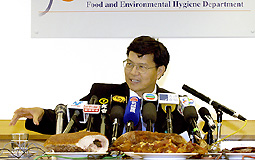 |
| Food for thought: Food & Environmental Hygiene Department's Consultant Dr Ho Yuk-yin advises against eating too much charcoal-grilled or dried meat as it contains high levels of cancer-causing chemical substances. |

|
The Food & Environmental Hygiene Department warns members of the public to avoid eating too much charcoal-grilled or dried meat as they contain high levels of cancer-causing chemical substances.
The level of polycyclic aromatic hydrocarbons - or PAHs, organic chemicals that are probably cancer-causing in humans - is generally higher in charcoal-grilled or dried meat, according to a risk-assessment study on barbecued meat the department recently completed.
Sixty food samples, including dried meat, "siu mei", barbecued pork, and roast pork and duck, cooked in a variety of ways, were collected for testing from food factories and restaurants across the territory.
The Food & Environmental Hygiene Department's Consultant Dr Ho Yuk-yin said three factors - using charcoal for grilling, a high cooking temperature and the close proximity of the meat to heating sources - could lead to higher levels of PAHs in barbecued meats.
Charcoal grilling increases PAH levels
"An analysis of the cooking methods for the 'siu mei' samples showed that charcoal grilling gave rise to significantly higher levels of PAHs than gas grilling or electric-oven roasting," Dr Ho said.
PAH concentrations for charcoal-grilled 'siu mei' ranged from 48.6 to 144.7 micrograms per kilogram, while those prepared by gas grilling or in electric ovens ranged from 5.1 to 10.4 micrograms per kilogram.
The PAH levels found in dried meat, cooked by electric or gas grilling, were as high as those found in charcoal-grilled 'siu mei'. PAHs levels were found to be generally higher after gas grilling rather than electric grilling.
Dried meats also contain high PAH levels
Also, dried meats cooked in similar ways were found to contain significantly higher PAH levels than those in barbecued pork since they are cooked closer to the heat source.
Relatively lower levels of PAHs were detected in roast duck samples, which are cooked at a lower temperature.
Dr Ho said the skin and fat of the charcoal-grilled ducks contained significantly higher levels of PAHs than the lean parts, 105.6 micrograms per kilogram compared with 2.1 micrograms per kilogram.
This was because the duck's outer parts are closer to the heat source when cooked, he added.
"Compared with overseas studies, the PAH levels in our barbecued meat were generally lower," he said.
Avoid having melted fat drip onto heat source
"This could be a result of the design of the local heating chambers, which could avoid melted fat dripping onto the heat source, causing the production of PAHs."
There are no safe levels regarding the intake of PAHs, he said, adding that efforts should be made to minimise human exposure to these organic chemicals.
He urged the trade to use gas grilling or electric-oven roasting to make "siu mei", and electric grilling to cook dried meat, to reduce PAH levels.
In addition, the heating chambers should be properly designed and the fat should be trimmed from the meat before cooking to stop the melted fat dripping onto the heat source, he said.
Avoid meat's direct contact with flame
"Direct contact of the meat with flame and high cooking temperature should also be avoided. Manufacturers are advised to pre-cook the meat so that a lower temperature will suffice for the roasting."
Dr Ho advised consumers not to over-indulge in barbecued meat, particularly charcoal-grilled ones and the skin and fat, and to remove charred parts.
"When barbecuing meat, the fat should be trimmed and the meat should be partially cooked beforehand," he said.
"Also, the charcoal should be put at the sides of the stove, while the meat should be placed in the centre to avoid melted fat from dripping onto the charcoal."
The findings of the study have been uploaded onto the department's website.
Go To Top
|



